Двигатель автомобиля BMW Z8
Под капотом — V-образная «восьмерка», хорошо
известная по BMW M5. Пять литров, 400 л.с. при 6600 об/мин и 500
Нм при 3800 об/мин. Не рекорд по литровой «отдаче», но абсолютные
значения впечатляют. Более чем убедительно для автомобиля массой
около полутора тонн: по поводу «за 5 секунд до 100 км/ч» — никаких
сомнений.
Алюминиевые блок и головки. Естественно, 4 клапана
на цилиндр. Конечно же — по два распределительных вала в каждой
головке. Само собой — фирменная система Double VANOS бесступенчатого
изменения фаз впускных и выпускных клапанов. «Персональные» дроссельные
заслонки на каждый цилиндр с электронным управлением: водитель нажимает
педаль, система управления рассчитывает оптимальную степень открытия
и дает команду, электродвигатель открывает заслонки. Время срабатывания
— 120 миллисекунд. Помимо обычного, есть и «спортивный» режим управления
дросселем.
В главной магистрали системы смазки — водо-масляный
теплообменник: для более быстрого прогрева при холодном пуске, а
главное — для лучшего охлаждения масла в «горячих» режимах. И еще.
Этот автомобиль способен проходить повороты со слишком большим боковым
ускорением. Настолько большим, что масло не возвращается из головок
V-образного блока (угол развала — 450) и его нужно откачивать. Поэтому
в системе смазки три насоса (один нагнетающий и два откачивающих)
и система управляемых электромагнитных клапанов. Когда автомобиль
движется по прямой, масло забирается из передней части головок.
При прохождении поворотов по сигналу датчика (используются датчики
ускорений системы стабилизации) электромагнитные клапаны переключаются,
и масло забирается из того места, куда оно отливает.
Ходовая часть автомобиля BMW Z8
Ее трудно «обвинить» в принципиальной новизне,
по крайней мере для BMW. Конструкция передней подвески давно и хорошо
отработана на седанах 5-й серии, но, конечно же, доработана «под
Z8». Это МакФерсон, рычаг которого состоит из двух. Оба — алюминиевые,
каждый соединен с поворотным кулаком своим шаровым шарниром. Подрамник
передней подвески сварен из алюминиевых профилей, и крепится к кузову
в шести точках.
Четырехрычажная задняя подвеска — доработанное
решение от BMW 7-й серии. Также собрана на алюминиевом подрамнике,
который крепится к кузову через массивные резиновые опоры. Рулевой
механизм — реечный, с переменным передаточным отношением и гидроусилителем.
Рулевые тяги — алюминиевые. Двухконтурная тормозная система — с
BMW 750i, но с доработками. Конечно же, вентилируемые диски на всех
колесах.
Но в наше время оптимальная развесовка и тщательная
доводка ходовой части — это еще не все. В современном спортивном
автомобиле много автоматических систем управления, связанных с активной
безопасностью (АБС, ПБС, система стабилизации, система распределения
тормозных сил)
И важно, чтобы выполняя свою работу, они не мешали
получать удовольствие от вождения. На BMW постарались: круг на 20-километровом
кольце Нюрбургринг Z8 с отключенной системой стабилизации проходит
за 8 мин 15 с, а с включенной — лишь несколькими секундами медленнее
Engine
Being the ultimate car in the Z series, the Z8 required a special engine. It was the all-aluminum 395 horsepower S62 V8 taken from the E39 generation M5. The engine was a high output variant of the M62 V8 which underwent a series of revisions from BMW Motorsport engineers,
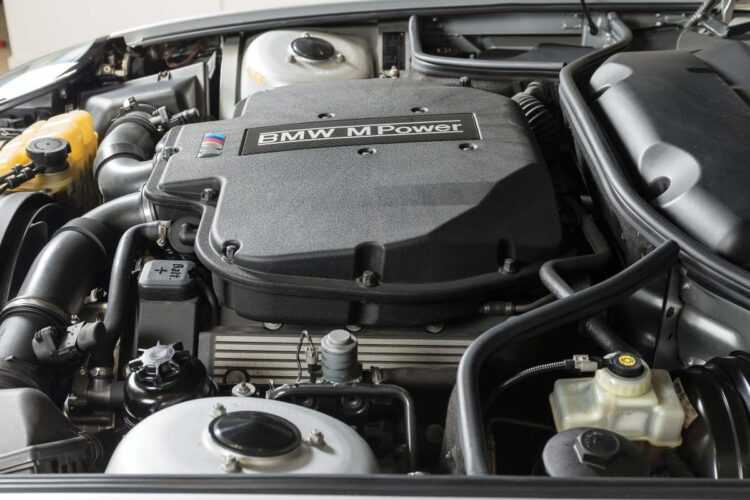
Peter Singhof 2017 Courtesy of RM Sotheby’s
The upgrades transforming the potent M62 into one of the most cherished BMW M engines included nodular cast iron hollow camshafts, semi-dry sump lubrication, eight electronically actuated individual throttle butterflies, larger dual air intakes, and mass flow sensors.
Moreover, the S62 got dual-VANOS variable valve timing of both intake and exhaust valves, a heavy-duty duplex timing chain, and a Siemens Motronic MSS 52 engine control unit. The unit oversaw vital components of the engine including an LED tachometer warning zone and M Driving Dynamics Control enabling Normal and Sport throttle response.
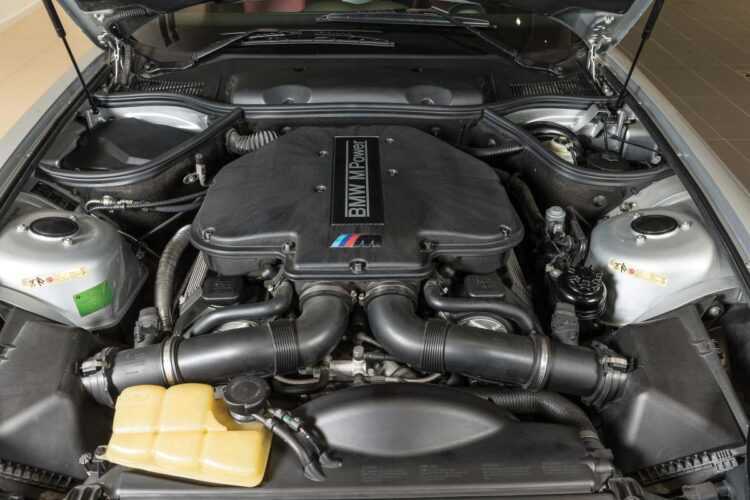
Peter Singhof 2017 Courtesy of RM Sotheby’s
The stroke and bore of the engine were increased from 82.7 mm to 89.0 mm and 92.0 mm and 94.0 mm respectively, giving the S62 the displacement of 4.9 liters and 394 horsepower at 369 lb-ft of torque. The engine produced peak horsepower at 6,600 RPM and maximum torque at 3800 RPM, while the rev limit was at 7000 RPM.
When the engine is first started, the tachometer’s warning zone (indicated by orange LEDs) begins at 4000 rpm. As the engine warms, LEDs are extinguished to lift the limit in increments of 500 rpm until the warning field begins at its normal 6500 rpm. The actual rpm limit is 7000.
Equipped with such a potent engine and with 6-speed manual transmission only, the BMW Z8 not only looked divine but had the performance to back up the heavenly design. Drivetrain-wise, the only thing that BMW Z8 didn’t inherit from the M5 was a limited-slip differential.
Given that the Z8 was powered by an M-engine, to a full-blown M car, the drive was softer and more amiable, but was far from boring. The 0-60 sprint took just 4.7 seconds and the top speed was electronically limited to 155 MPH, although there were rumors of a maximum velocity 180 MPH.
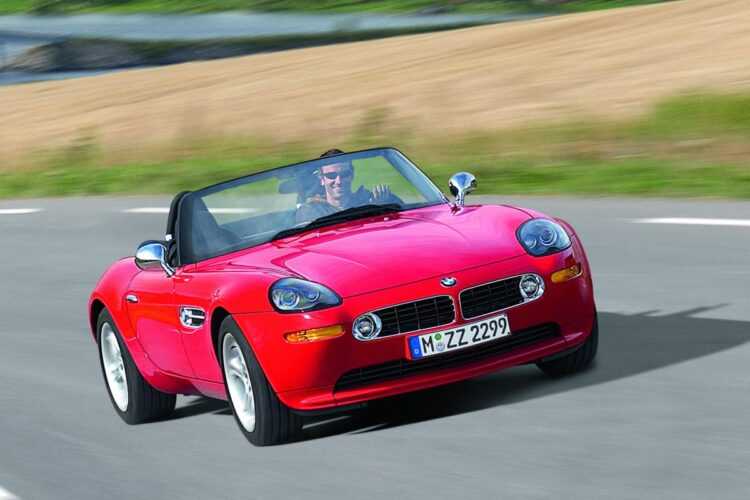
Source: BMWGroup
These numbers made clear that BMW brought something more than just a costly cruiser capitalizing on nostalgia because the Z8 was a car generously giving back to its driver. The Z8 was acclaimed for a balanced driving experience, and the handsome roadster package just animated the public to love it even more. It wasn’t a bona fide sports car, yet was engineered to give it all while on long indulging drives through the perfect scenery.
Suspension and Steering
To offer a balance between a sports car and a relaxed cruiser, the Z8 utilized McPherson struts at the front and a multi-link rear with twin-tube gas shocks in the front and in the back. In efforts to shed weight and further refine the driving feats, gentle and lightweight aluminum was used for constructing the suspension set-up.
As previously mentioned, the Z8 wasn’t meant to be an M-car, even though it had an S-coded V8, so the suspension was soft and engineered for cruising and spirited driving rather than shedding seconds on the tracks.
As a pioneering feature on a V8-powered BMW, the Z8 had rack-and-pinion steering with a variable ratio. The steering was set to go hand in hand with the character of the car and as such, it was more suitable for light and carefree journeys. Some journalists found the steering to be too imprecise, misjudging the Z8’s main purpose.
Кузов автомобиля BMW Z8
Несущий, и впервые для BMW — полностью алюминиевый.
Низкая масса, высокая коррозионная устойчивость. Недешево, но, как
оказалось, в мелкосерийном производстве оправдано, даже в сравнении
с традиционным стальным.
Основа кузова — «пространственная рама»: горячештампованные
профили и панели, соединенные между собой заклепками (около 1000
шт.) и сваркой в среде инертного газа (57 метров сварных швов).
Идеологически — ничего нового по сравнению с Audi. Если не считать
того, что BMW применила алюминиевый кузов для родстера, преодолев
при этом весьма серьезные специфические противоречия. Ведь к кузову
спортивного автомобиля очень высоки требования по жесткости (она
непосредственно связана с управляемостью, да и проблемы пассивной
безопасности решать надо), а открытый автомобиль лишен крыши и стоек
кузова — важных частей силовой структуры.
Основные несущие элементы пространственной рамы
(центральный тоннель, пороговые брусья, передние «лонжероны», к
которым крепится силовой агрегат) соединены в виде двух огромных
букв «Y», что обеспечивает не только жесткость конструкции, но и
оптимальное распределение энергии удара при столкновениях. А «имиджевая»
высота тоннеля имеет и вполне практическое объяснение: в обеспечении
жесткости средней части кузова тоннель «играет первую скрипку».
Жесткость тоннеля Z8 настолько высока, что пороги (тоже существенный
элемент жесткости!) удалось сделать довольно низкими, по крайней
мере — для автомобилей такого типа.
Interior
Just like the body, the interior also drew on the 1950s, alas it didn’t mirror the 507’s massive round instruments positioned directly behind the steering wheel.
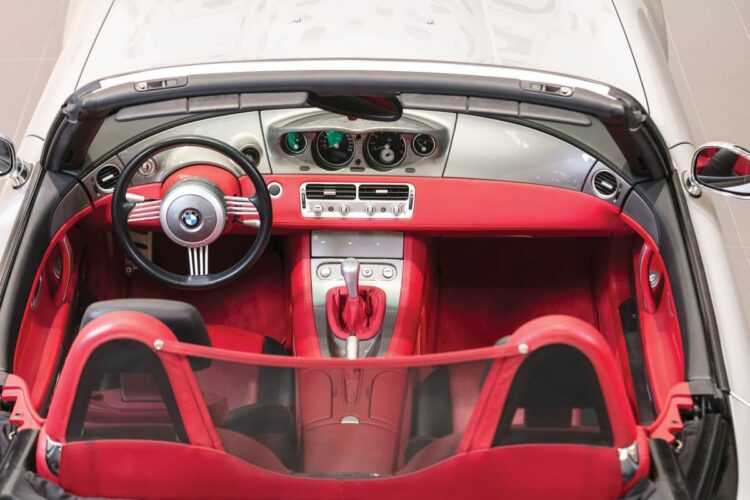
Peter Singhof 2017 Courtesy of RM Sotheby’s
On the contrary, interior designer Scott Lempert moved the instrument cluster to the middle of the car, slightly tilting it towards the driver’s side. The dashboard was finished in either brushed aluminum or black piano lacquer, emulating the look of are metal panels usually found in 1950s automobiles. The central placing on the instruments was there to free the driver of any distractions from the roads ahead, even if it sometimes meant breaking the speed limit.
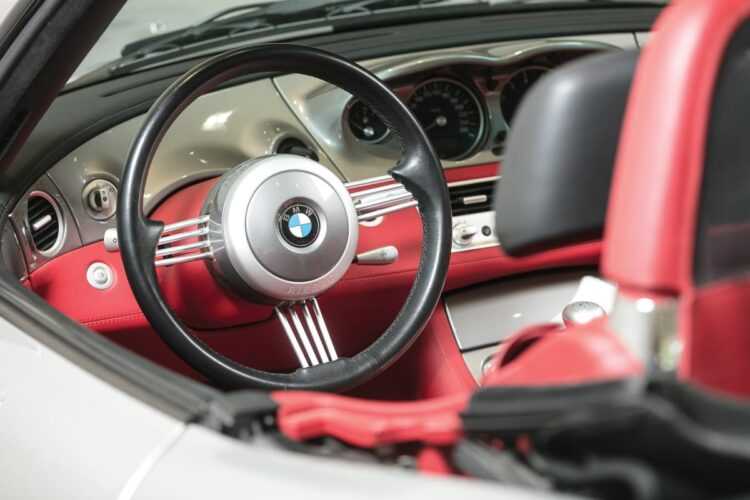
Peter Singhof 2017 Courtesy of RM Sotheby’s
The perfectly proportioned three-spoke leather steering wheel was a beautiful reimagination of 1950s design with subtle art deco inspiration. In efforts to keep the interior simplistic and uncluttered, BMW took special care in allocating the commands and giving them unique design. That being said, not a single button or a knob is shared with another BMW from the period and each is designed to fit the retromodern theme. Interestingly, the Z8 had a starter button positioned above the ignition lock, quite a modern feature for a retro interior.
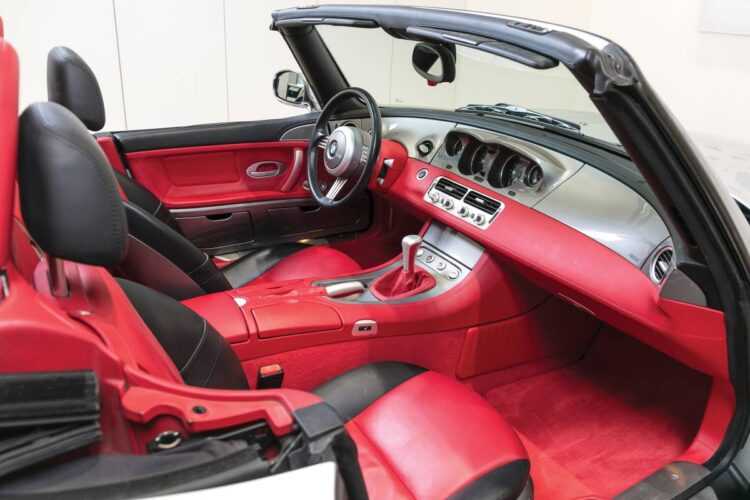
Peter Singhof 2017 Courtesy of RM Sotheby’s
As the only feature which couldn’t be designed in lieu of the rest of the interior, the Multi-Information Radio unit has been cleverly hidden away behind a retractable color-coded panel below the climate controls. Finally, Lempert completed the interior design by placing the Z8 badge right between the headrests.
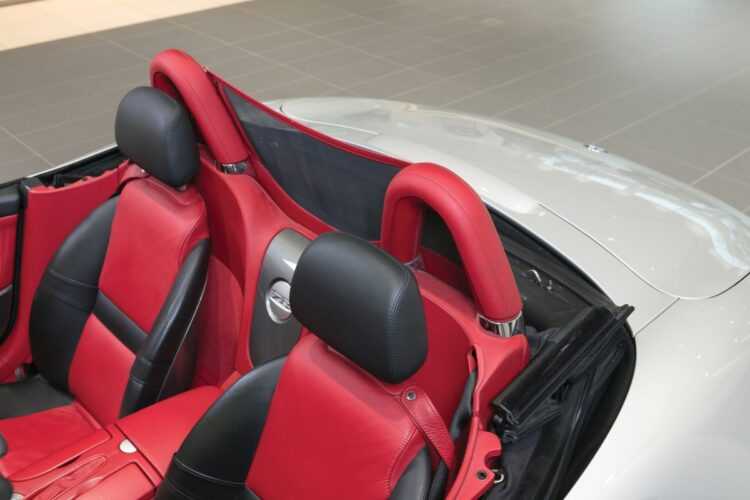
Peter Singhof 2017 Courtesy of RM Sotheby’s
Alpina Roadster V8[]
Alpina Roadster V8 with the hardtop in place
With production of the Z8 completed by November 2002, the Z8 was replaced by the Alpina Roadster V8 in 2003. The Alpina was a departure from the hard-edged sporting focus of the original car, and elements of grand touring intent were evident throughout this final iteration. Instead of the original 6-speed manual and 4.9 L (S62) engine featured in original Z8, the Alpina came only with an automatic transmission, utilising a 5-speed BMW Steptronic transmission mated to a 4.8 L Alpina-tuned BMW M62 V8 engine from the Alpina E39 B10 V8 S. In order to complete the car’s transition from a sports car to a refined grand tourer, a softer suspension setting was used. The standard Z8’s run-flat tyres on 18 in ( cm) wheels were discarded in favor of conventional tyres with softer sidewalls mounted on 20 in ( cm) Alpina wheels. A new softer grade of Nappa leather replaced the Z8’s less supple specification, and special Alpina gauges were fitted on the dash board cluster. An Alpina steering wheel with three solid spokes replaced the original, which could not be retrofitted with shift paddles for the automatic transmission. Gear selection was displayed in an Alpina-specific display mounted in front of the steering wheel.
Performance and power output of the Alpina roadster V8 differed from that of the standard car in that the peak power was reduced to 280 kW (381 PS; 375 hp), while peak torque was raised to 383 lb·ft (519 N·m); this torque was available at significantly lower rpm than the original in order to enable more relaxed cruising. Curiously, the electronically limited top speed was officially raised to 161 mph ( km/h).
Production of the Roadster V8 amounted to 555 units, 450 of which were exported to the U.S. market and only eight to the UK. In the United States, this special edition of the Z8 was sold directly through BMW dealerships, marking a first for Alpina, whose cars had never been sold through retail channels in the U.S.
Specifications and features[]
The Z8 cost US$128,000, had an all-aluminium chassis and body, and used a 4,941 cc (4.9 L; 301.5 cu in) V8 engine which has a power output of 400 PS (294 kW; 395 hp) at 6,600 rpm and 500 N·m (369 lbf·ft) of torque at 3,800 rpm. This engine, known internally as the S62, was built by BMW Motorsport and was shared with the sports saloon. The engine is located behind the front axle in order to provide the car with a 50/50 weight distribution. The factory claimed a acceleration time of 4.7 seconds; Motor Trend magazine achieved in 4.2 seconds. Road & Track measured the car’s lateral grip at 0.92. Car and Driver magazine also tested the car and found that it outperformed the contemporary benchmark Ferrari 360 Modena in three important performance categories: acceleration, handling, and braking. As with most BMW automobiles the top speed of the Z8 was electronically limited to 155.4 mph (250 km/h) with the delimited top speed amounting to an estimated 290 km/h (180 mph).
The Z8 used neon exterior lighting, the tail lights and turn indicators are powered by neon tubes that offer quicker activation than standard lightbulbs and are expected to last for the life of the vehicle. Due to the quirk in the US FMVSS regulations, the turn signal indicators in the tail lights are entirely in red colour.
Every car was shipped with a colour-matching metal hardtop with a rear defroster. Unlike many contemporary hardtops, which are provided for practical rather than stylistic considerations, the hardtop of the Z8 was designed from the outset to complement the lines of the car’s styling.
In order to keep the interior uncluttered, a number of functions were integrated into multifunction controls. For example, the power windows and mirrors were controlled by a single instrument. Also, the centre-mounted instrument cluster was canted slightly toward the driver. The displacement of gauges to the middle of the dashboard was intended to offer an unimpeded view of the hood and the road ahead.
In order to promote the Z8 to collectors and reinforce media speculation about the car’s «instant classic» potential, BMW promised that a 50-year stockpile of spare parts would be maintained in order to support the Z8 fleet. Due to the limited volume of production, all elements of the car were constructed or finished by hand, thereby compounding the importance of ongoing manufacturer support for the type. The price and production process allowed BMW to offer customised options to interested buyers. A significant number of cars with bespoke paint and interior treatments were produced over the course of the four-year production run by BMW Individual, a division of BMW AG.
Construction
The BMW Z8 was built using a lightweight aluminum space frame, enabling substantial structural rigidity for a roadster combined with low weight. Without the hardtop, the car weighed 3,494 lb, compared to 3,554 lb with the top on.
The frame was made of extrusion-pressed beams with almost 1,000 rivets and around 190 ft. of fused welding seam (MIG) to hold the frame and the body panels together.
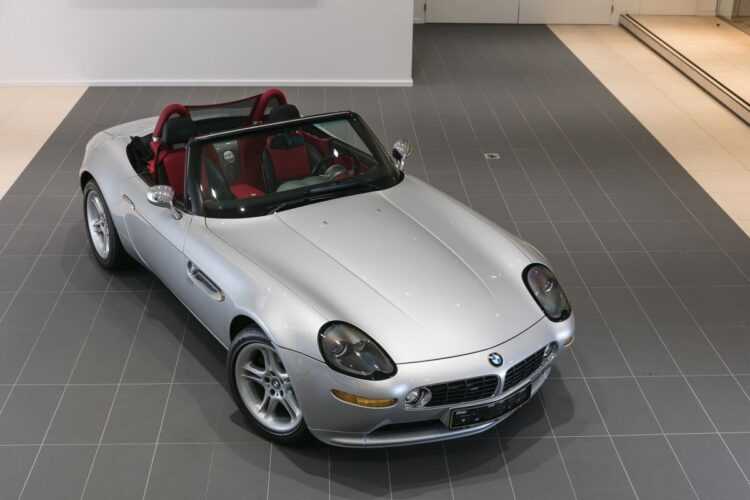
Peter Singhof 2017 Courtesy of RM Sotheby’s
Most of the production was completed at BMW’s Dingolfing plant, while some parts like the plastic front and rear bumper were made at the Landshut factory. The final assembly was carried out at a dedicated production line by a team of skilled employees in 31 assembly steps.
In popular culture[]
The Z8 was showcased as James Bond’s car in the film The World Is Not Enough released in November 1999, from scenes shot in early April 1999. In the film, it is driven by Bond for his mission in the Azerbaijani town of Neft Dashlari until it is sliced in half by a helicopter equipped with cutting saws. The vehicle is equipped with surface to air missiles that is mostly activated through the car’s steering wheel used as a targeting display, and can also be remote controlled through the use of the vehicle’s keychain. This was the final BMW car to appear in the James Bond franchise as its 3-year film deal with BMW expired. It later reappeared in the James Bond video games 007 Racing and Agent Under Fire, the latter of which featured the car on the cover. The Z8 can also be driven in the video game Need for Speed: Hot Pursuit 2. Additionally, the car is driven by Jackie Chan’s and Jennifer Love Hewitt’s characters in The Tuxedo released in September 2002.
Z07 Concept[]
The Z07 Concept had been based on the concurrently running E52 development programme. As a result, practical and regulatory considerations necessitated very few changes for the production model. Comparatively, the windshield of the series production Z8 was more upward, and the car had a larger front airdam. The Z8 hardtop differed from the Z07 in being a double-bubble form with a tapering fairing versus a single dome with a truncated convex rear. The Z07’s exotic driver’s side helmet fairing was never intended for production, in order to allow easy operation of the power soft top.
The Z07 was an homage to the iconic BMW 507
The side turn signal repeaters were integrated into the side vents in a fashion that rendered them invisible until activated. The vintage simplicity of the interior was preserved by hiding the modern equipment under retracting panels. Complex compound curves were made through the use of an expensive MIG-welded aluminium space frame.
Все поколения BMW Z8
2000 – 2003
Кабриолет
Сегодня в продаже
-
870 000 руб.
Citroen C4 -
0 руб.
LADA (ВАЗ) 2109 -
600 руб.
BMW 6 серия -
590 000 руб.
Volvo S80 -
210 000 руб.
Mercedes-Benz E-klasse -
450 000 руб.
Volkswagen Polo -
892 000 руб.
Mercedes-Benz GL-klasse -
1 960 000 руб.
Mazda CX-5 -
2 800 000 руб.
Mercedes-Benz E-klasse -
445 000 руб.
2121 (4×4) -
160 000 руб.
LADA (ВАЗ) Granta -
67 000 руб.
LADA (ВАЗ) 2114 -
825 руб.
Kia Optima -
222 руб.
Toyota YarisNjvc
-
222 руб.
Toyota Yaris -
23 222 руб.
Lexus RX -
1 140 000 руб.
Mercedes-Benz C-klasse -
400 000 руб.
Toyota Corolla -
3 800 000 руб.
Mercedes-Benz G-klasse AMG -
3 800 000 руб.
Mercedes-Benz G-klasse AMG -
7 000 000 руб.
BMW X7 -
1 490 000 руб.
Ford Explorer -
7 000 000 руб.
BMW X7 -
1 950 000 руб.
Ford Explorer -
400 000 руб.
ГАЗ 24 «Волга» -
2 800 000 руб.
Mercedes-Benz GL-klasse
Последние автоновости
-
Автожурнал «За рулем» протестировал недорогой седан Livan S6 Pro стоимостью от 2,55 млн рублей
-
Бренд Tank представит в России несколько новых моделей автомобилей в 2024 году
-
Kia начинает отзыв моделей Soul и Seltos 2024 года из-за проблем с раскрытием подушек безопасности
-
Tesla представила матово-черный Cybertruck на Art Basel Miami
-
Сможет ли генеральный директор GoPro обогнать Стига из TopGear на Porsche 911 Turbo
-
Эксперт рассказал о надежных и доступных иномарках до 500 тысяч рублей
-
Китайские автобренды вводят скидки до 1,1 млн рублей в России
-
Эксперты рассказали о синтетическом моторном масле, и каким оно бывает
-
В России начнут использовать новый способ для поиска угнанных автомобилей
-
Quto: автозавод УАЗ ввел новый тест кузова внедорожника «Патриот» на герметичность
-
«Автотека» назвала ВАЗ самой востребованной маркой малолитражных автомобилей в России
-
В России запустили продажи кроссоверов Hyundai Bayon дешевле китайских авто
-
Постояльцам этого отеля дадут покататься на старых и новых Toyota Supra
-
В РФ запустили в продажу электромобиль Chery eQ7 из параимпорта почти за 3 миллиона
-
Автозавод «Автотор» приступил к выпуску новых кроссоверов Kaiyi X7 Kunlun
-
Дилерам запретили делать огромные наценки на продаваемые авто
-
Эксперты из Германии опровергли надёжность моделей Logan и Duster по итогам техосмотров
-
В Сети нашлись эскизы элементов новой бюджетной модели LADA Iskra
-
ТАСС: Кроссовер «Москвич 5» может выйти на рынок РФ в первой половине 2024 года
-
Для мэрии Омска закупают перламутровые кроссоверы за 2 млн рублей
-
Opel представил семиместный электрический минивэн Combo Electric
-
ТАСС: В России нашли способ снизить цены на автомобили и мотоциклы с пробегом
-
Автоэксперты Autonews: не стоит не спешить с покупкой автомобиля из КНР
-
Электрический пикап Tesla Cybertruck получил спецрежим для езды по воде
-
Обновленный Ford Kuga 2024 года попал в объективы шпионских фотокамер
-
Kia отзывает Seltos и Soul из-за взрыва подушек безопасности без всякой причины
-
Lexus рассекретил цены на новый внедорожник Lexus GX 2024 года
-
Skoda нашла в Казахстане производственную площадку для сборки Octavia, Kamiq, Karoq и Kodiaq
-
Zeekr представил в Европе свой первый электромобиль 536-сильный Shooting Brake
-
Немецкий рынок гибридных автомобилей испытывает серьезные проблемы и сокращается на 40%
-
Эксперты INSIDEEVs провели тест-драйв нового Chevrolet Blazer EV RS
-
Tesla объявила отзыв для порядка 2 млн электромобилей из-за проблем с автопилотом
Автосервисы в России
-
Миллениум Авто
-
Автоэлектрик Чип Тюнинг
-
DiaScanAvto
-
Шиномонтаж
-
Автосервис Chip-Avto
-
Самурай
-
Арт-Сервис
-
Шинсервис
-
Ремонт радиаторов и интеркулеров
-
Хонда-сервис
-
Автотехцентр Вираж
-
Графф Сервис
-
Автомойка
-
АвтоГЕРМЕС LADA Волгоградский пр-т
-
Престиж-Авто Chevrolet Мурманск
-
Автодоктор 161
-
DenStyle
-
ГБО
-
Чип Ателье
-
АвтоРай
-
Эпога
-
Апельсин
-
Автомойка
-
Аларм-Моторс Peugeot Юго-Запад
-
Авто Врн
-
Шиномонтаж
-
Tunnel
-
Эл-Зап Екатеринбург
-
Чип-тюнинг Rivaracing
-
Fleet Service Partners
-
Lux express
Legacy
In spite of their similarities, the 507 which held high hopes for a developing small company BMW was and the Z8 of the automotive giant BMW we know today were two fundamentally different cars.
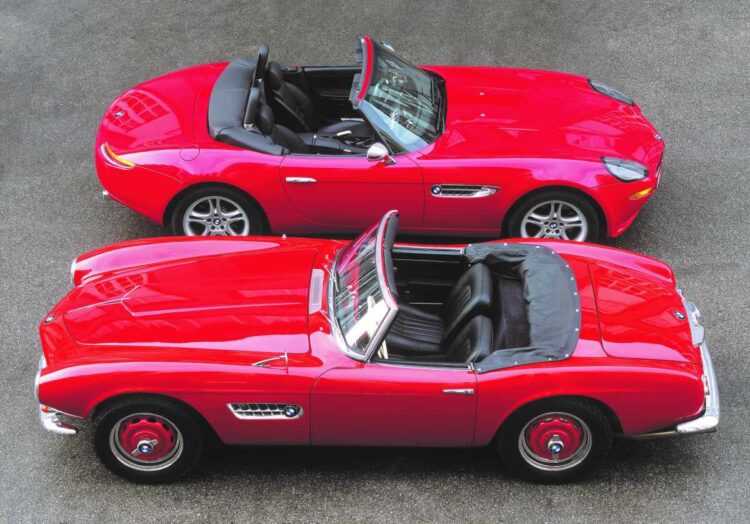
BMW Z8 and 507. Source: BMWGroup
From the start, BMW produced the Z8 to be a desirable collector car. Each example came with ample equipment, a guaranteed 50-year spare part production run, and a matching hardtop as standard.
With the Z8, BMW didn’t offer just a car, but an experience for itself; US-based customers were granted an exclusive Z8 Driving Experience at BMW’s Performance Center Driving School in California and each owner got an individually numbered booklet covering the Z8’s creation from initial drawings to the production stage of the exact cars, complete with paint and upholstery samples. Also, BMW offered a scale car replica of each individual Z8 produced.
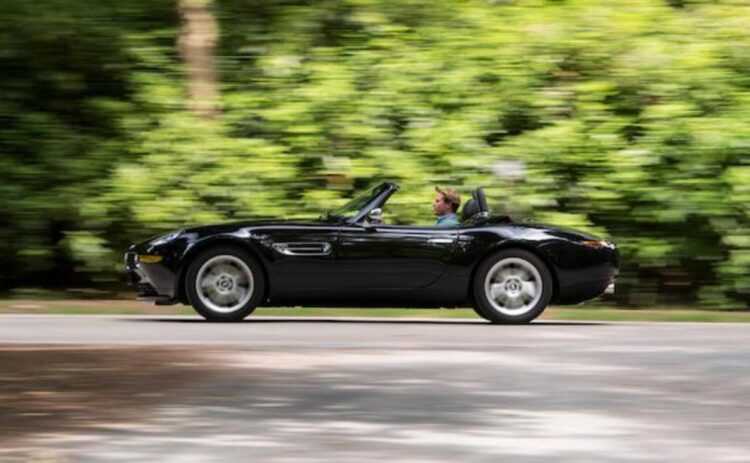
Source: Bonhams
Given that the Z8 still commands six-figure prices, often above the original MSRP of $128,000 means only one: BMW had done it right. This mega roadster is a perfect drivable modern classic balancing between a supercar and an elegant plush cruiser and it’s one of the most sought after BMWs today.
Apart from its collector car value, the Z8 holds an important role in BMWs history. Following the end of production in 2003, BMW started evoking its past more often, sometimes in the form of various homages in the past, or less obviously by adding subtle styling touches in its current cars. After all, BMW has so much to be proud of, even if it is a car that nearly became a swan song more than half a century ago.
Body
The all-aluminum body of the Z8 designed by Henrik Fisker was so enamored with the idea of creating this car that he zealously worked on it over his summer holiday, penning the design of the production car.
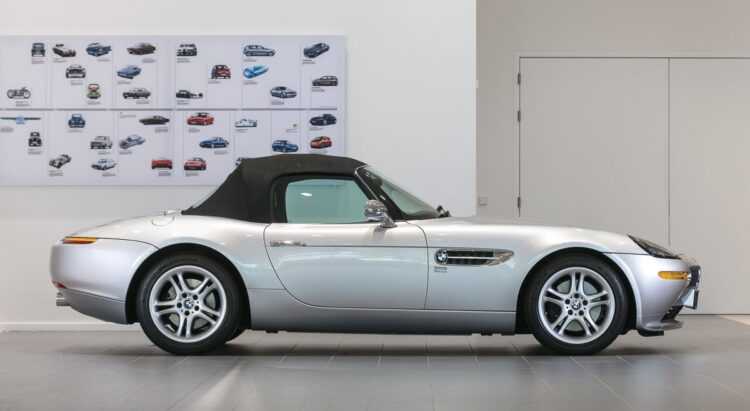
Peter Singhof 2017 Courtesy of RM Sotheby’s
The Z8 didn’t differ much from the Z07 concept, yet it was retouched to better suit a production car. Compared to the concept, the Z8 lost two distinctive features, the 1950s racing-inspired helmet fairing and the double bubble for the removable hardtop. The former feature had to be changed to allow for easier movement of the soft top, while a single curve of the hardtop suited the lines of the Z8 better.
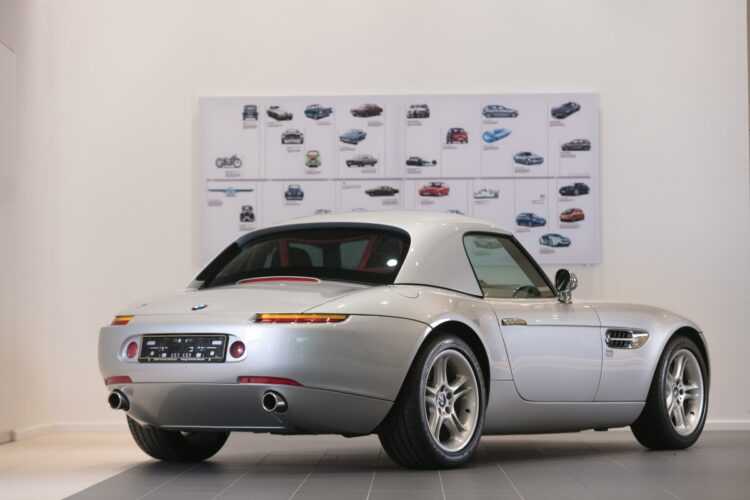
Peter Singhof 2017 Courtesy of RM Sotheby’s
The wide nostril grilles were the defining feature of the 507 and in modern Z8 guise they were given a perfect 2000s makeover, and so were the chrome gills on the front fenders. In true flagship manner, the Z8 stood out from the rest of the BMW range while simultaneously carrying the company’s DNA.
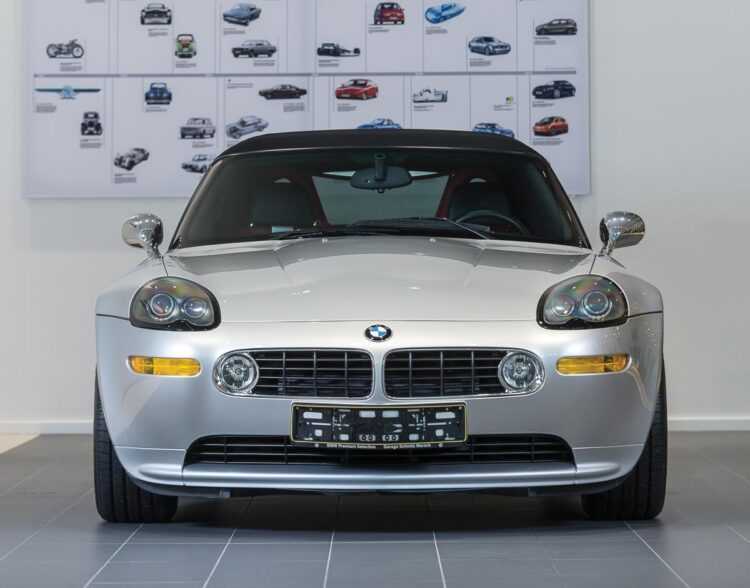
Peter Singhof 2017 Courtesy of RM Sotheby’s
Interestingly, the Z8 didn’t have any badging apart from the roundels in the front, on the trunk lid, and inside the fender gills, just like on the 507. The clean rear lights completed the retro-modern look, but lights carried a unique technology hiding behind the lenses. Instead of traditional light bulbs, the Z8 had neon turn signals and rear lights, with Xenon headlights in the front.
In addition to factory finishes, the customers who wanted more from their Z8 could personalize their car through the BMW Individual program. Rare examples, just 19 of them, sported a bi-color exterior finish: eleven cars sported cream-on-Stratus silver, seven were finished in silver-on-black and just one in Carbon Black/Silver with light silver grey interior.
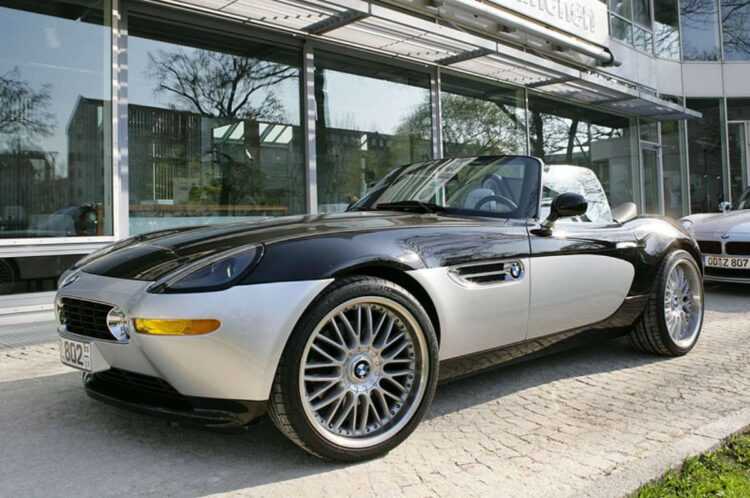
One of only seven Black/Silver BMW Individual Z8’s. Source: BMWZ8.US
Brakes, Wheels and Tires
For the Z8, BMW needed capable brakes, but necessarily sporty ones used on the M5. So, the brakes were borrowed from a range-topping sedan, the V12-powered 750 iL. The ventilated rotors measured 334 mm in the front, 328 mm at the rear, and stopping power was ensured via two-piston front calipers in the front and single-piston calipers in the rear.
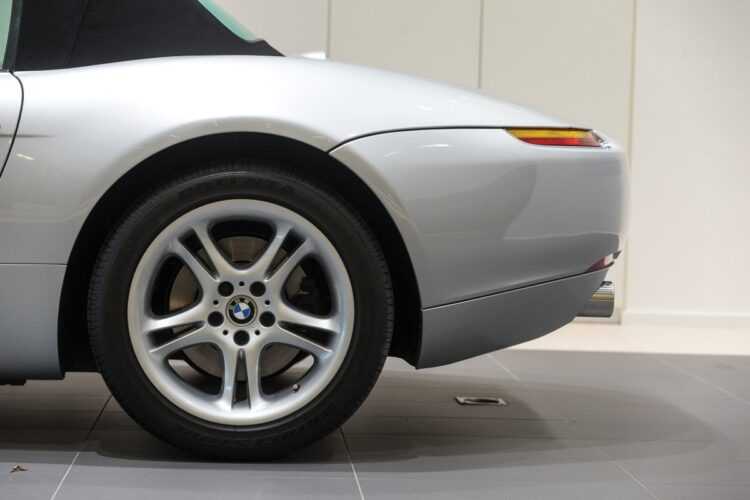
Peter Singhof 2017 Courtesy of RM Sotheby’s
The Z8 had a single slightly concave five-double spoke wheel design measuring 18X9 in the front and 18X9 in the back. Paired with the wheels were 245/45R-18W front and 275/40R-18W run flat tires, first of its kind on a European production car.
Alpina Roadster V8
Whereas some elements of the BMW Z8, most notably the engine, were clearly performance-oriented, it was still a step closer to an old-school grand tourer. However, some potential buyers found it too engaging, particularly due to the fact that it only had a manual transmission.
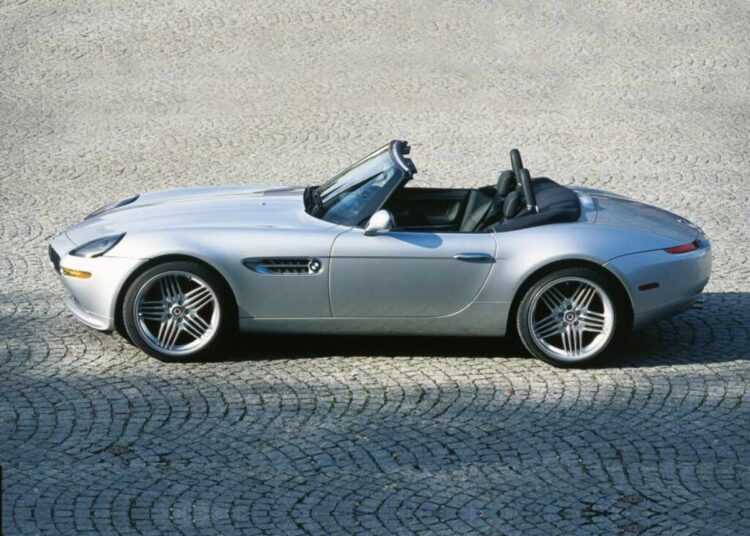
Alpina Roadster V8. Source: BMW Group
To address this, BMW partnered with Alpina to produce a limited run of 555 cars in 2003, the last production year of the Z8. Out of a total production run, 450 went to US soil where they were sold through BMW’s official dealership network.
The car was comprehensively revised to provide a more delicate grand touring experience. Instead of the M5-derived S62, the Alpina Roadster V8 sported a modified 4.8-liter M52 producing 375 horsepower, less than the Z8, but the torque output was increased to 383 lb-ft, granting more relaxed power delivery. Still, Alpina raised the top speed limit to 161 MPH, signifying that the downtuned Z8 could still provide a thrilling ride if needed.
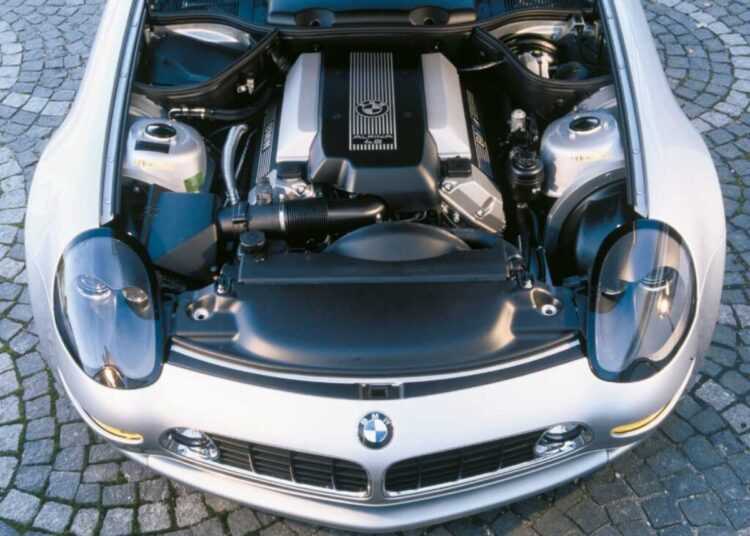
Source: BMWGroup
The gearbox of the Alpina Roadster V8 was a 5-speed BMW Steptronic exclusively and it came with push-button shifters integrated into the modified steering wheel. The dashboard was also revised with custom Alpina dials and a new instrument, a digital gear indicator positioned right behind the steering wheel. The interior also used more delicately grained Nappa leather and introduced new color options.
Alpina made the suspension softer and the run-flat tires on 18-inch wheels were dropped in favor of 20-inch Alpina five-multispoke wheels with conventional tires with softer sidewalls, thus completely redefining the driving experience.
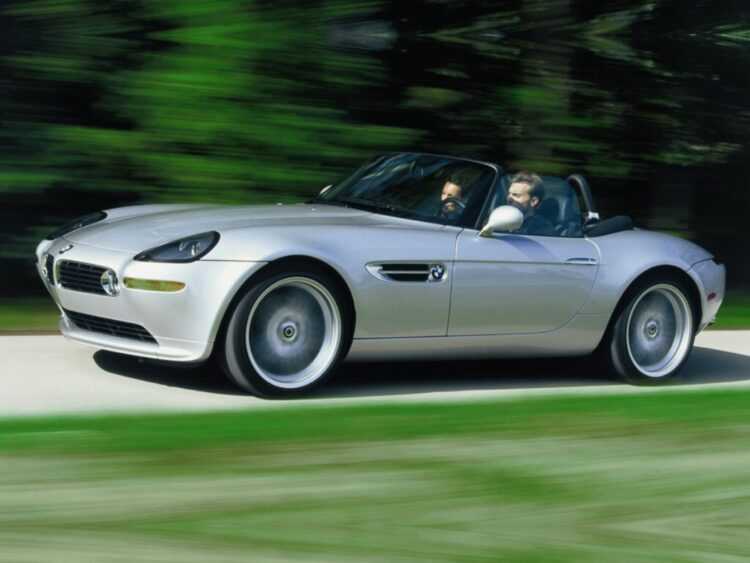
Source: BMWGroup
Both inside and out, Alpina redefined the Z8 into a true European grand tourer for the American roads and this time on purpose, the production numbers were much closer to the 507’s.
Development of the BMW Z8
The 1990s were the times when numerous leading brands turned to their past to reinterpret it for the 21st century. At the same time, BMW officials turned to the company’s roots, wondering how the 507 would evolve had BMW managed to conquer North America in the 1950s.
Chief designer Chris Bangle wanted to explore this what-if scenario with a series of Z07 concepts. These retro-futuristic design studies envisioned a roadster and a bubble-top coupé taking immediate inspiration from the 507. Even its name inevitably pointed to the archetypal BMW open-top cruiser.
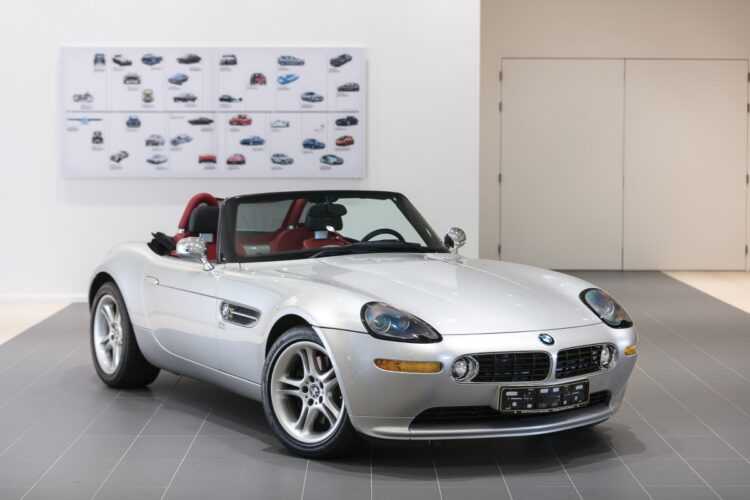
2001 BMW Z8. Peter Singhof 2017 Courtesy of RM Sotheby’s
In parallel with the concepts, BMW already planned a restricted number of production cars, testing the waters at the 1997 Tokyo Motor Show. Followed by a positive reaction of the automotive public, BMW proceeded with the development of the flagship cruiser. Being the range-topping offering in the Z roadster family, the roadster was christened Z8.
The production version of the car debuted on the big screen as James Bond’s car in ‘The World Is Not Enough’. There, Pierce Brosnan’s final rendition of the 007 cemented BMW’s intention to unveil and market the Z8 as an instant classic. The Z8 was BMW’s third official Bond car, and it was by far the most appropriate one, serving as a climactic follow-up to the Z3 and the E38 750iL featured in GoldenEye and Tomorrow Never Dies.
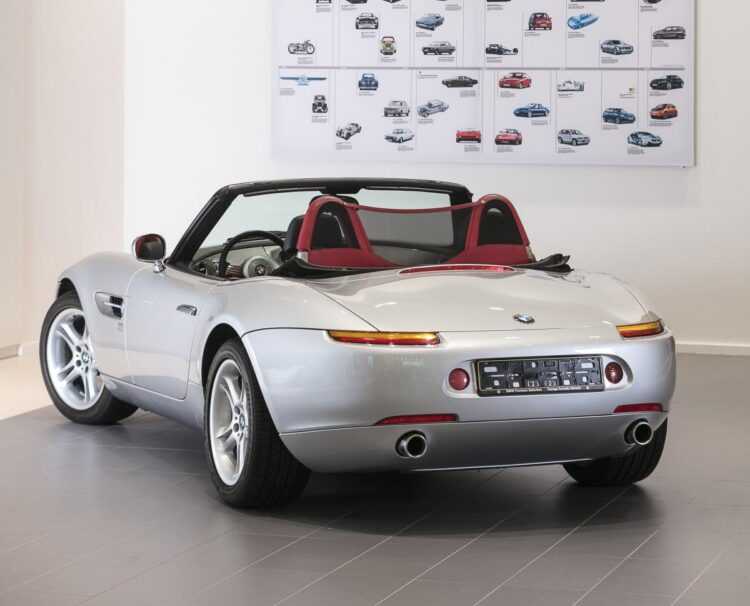
Peter Singhof 2017 Courtesy of RM Sotheby’s
Needless to say, a limited run of 5,703 examples was sold from 2000 to 2003, with 2,543 of them ending up on the North American market.
References[]
-
«Car and Driver Aston Martin DB7 vs. BMW Z8, Ferrari 360 Spider Comparison Test». http://media.caranddriver.com/files/aston-martin-db7-vs-bmw-z8-ferrari-360-spiderthe-princes-of-performance-2.pdf.
-
«Z8 History». Bmwz8.us. http://www.bmwz8.us/forum/bmw-z8-history-technical-info-pdf-movies/z8-history-29.html.
- The BMW Z8 birth book/coffee table book which was issued to every BMW Z8 owner
- http://www.bmwz8.us/pdf/1996_06_car.pdf[bare URL PDF]
-
«BMW Z07 Concept» (in en-US). BMW BLOG. 2015-05-20. https://www.bmwblog.com/2015/05/20/flashback-bmw-z07-concept/.
-
«BMW’s Z8: Structurally Shaky?». https://www.bloomberg.com/news/articles/2006-01-18/bmws-z8-structurally-shaky-businessweek-business-news-stock-market-and-financial-advice.
-
(in en). .
-
«BMW M MotoGP». https://www.bmw-m.com/en/fastlane/motogp.html.
-
↑ Hutton, Ray (February 2003). «BMW Alpina Roadster V-8». Car and Driver. http://www.caranddriver.com/reviews/bmw-alpina-roadster-v-8-first-drive-review.
-
«Let’s all stare at this gorgeous Z8 Alpina Roadster» (in en). Top Gear. 2018-05-23. https://www.topgear.com/car-news/classic/lets-all-stare-gorgeous-z8-alpina-roadster.
-
«Alpina Z8 Roadster Is Asking for $244,900 to Come Home with You» (in en-US). BMW BLOG. 2017-08-28. https://www.bmwblog.com/2017/08/28/alpina-z8-roadster-asking-244900-come-home/.
-
Buckley, Martin. «BMW Aplina Roadster V8». Evo. http://www.evo.co.uk/carreviews/evocarreviews/32925/bmw_aplina_roadster_v8.html.
-
«Bertone Birusa | Concept Cars | Diseno-Art». http://www.diseno-art.com/encyclopedia/concept_cars/bertone_birusa.html.
-
«2003 Bertone Birusa: Concept We Forgot» (in en). Motor1.com. https://www.motor1.com/news/180973/concept-we-forgot-bertone-birusa/.
-
«Produktion Z8». BMW. http://www.bmw-werk-muenchen.de:80/muenchen/htdocs/deutsch/produktion/z8/index_z8_dia.html.
-
«BMW Group Plant Munich History» (in en). https://www.bmwgroup-plants.com/muenchen/en/our-plant/history.html.
- BMW Z8 Club e.V.
-
«Annual Report 2000». BMW. http://www.bmwgroup.com/publikationen/e/2002/pdf/01_BMW_GeBe2000_en.pdf.
-
«7.3 007-The World Is Not Enough». Azer.com. 1942-09-25. https://www.azer.com/aiweb/categories/magazine/73_folder/73_articles/73_bond.html.
-
«2001 BMW Z8 Reviews by Cars.com Experts and Consumers». Cars.com. http://www.cars.com/go/crp/research.jsp?makeid=5&modelid=4787&year=2001§ion=reviews.
-
«2002 BMW Z8 Summary». Cars.com. http://www.cars.com/go/crp/research.jsp?makeid=5&modelid=4787&year=2002§ion=summary.
-
↑ «BMW Group Shatters All Past Annual Sales Records in 2004». Theautochannel.com. 2004-11-17. http://www.theautochannel.com/news/2005/01/04/313805.html.
Background
The car that influenced BMW to create the Z8 was arguably one of the most beautiful silhouettes that ever came from Münich. The BMW 507 was envisioned as a luxurious grand touring convertible primarily built for the blossoming American market in the late 1950s.
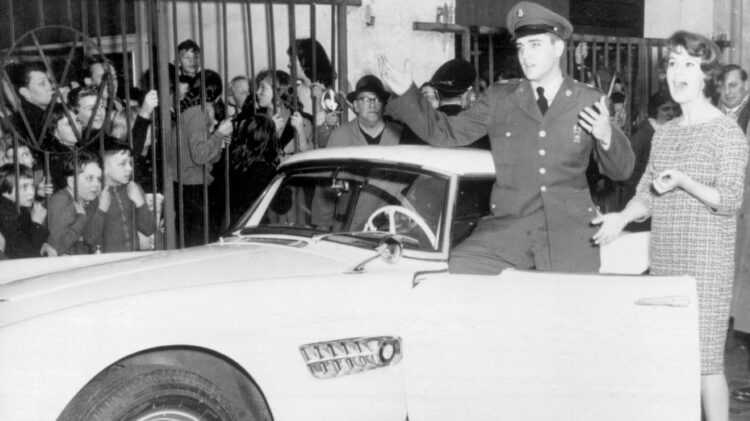
Elvis Presley outside his white BMW 507
The 507 was a brainchild of Max Hoffman, an influential Austrian-born American entrepreneur who built his fortune and reputation as an importer of European luxurious cars in the 1950s. Hoffman himself suggested Mercedes-Benz should convert the W194 race car into the 300SL Gullwing and Porsche to build the iconic 356 Speedster. With the BMW 507 and 503, Hoffman aimed to fill in a gap between the 300SL Roadster and the less expensive British marques.
Its carefully dosed use of chrome decor and swooping lines put it on par with the most exquisite cars of its era, but none of it was enough to save BMW from a financial dire strait. On the contrary, the company nearly went bankrupt as a result of astronomical building costs leaving BMW losing money on each example produced.
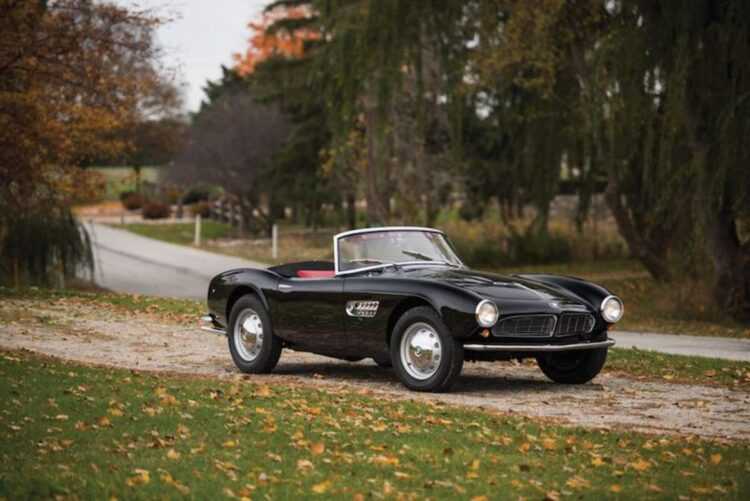
1959 BMW 507 Roadster Series II (photo: Darin Schnabel) RM Sotheby’s
A drastic increase in production costs reflected in a proportional increase in the sticker price. A far cry from Hoffman’s predictions, the 507 flopped with just 252 examples produced between 1955 and 1959 run.
Fast forward a couple of decades, BMW rapidly progressed to become one of the most recognizable brands in the world, while the 507 established itself as the pinnacle of post-war BMW and a highly regarded collector’s car.





























